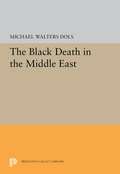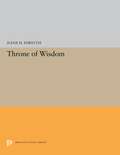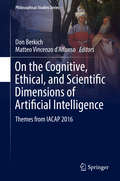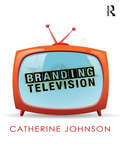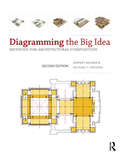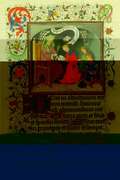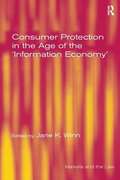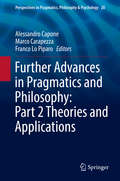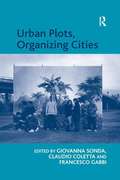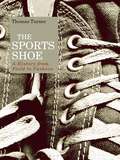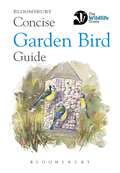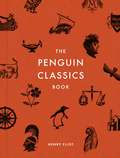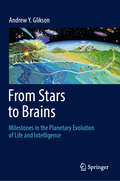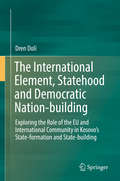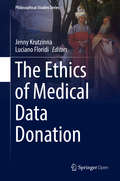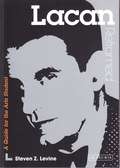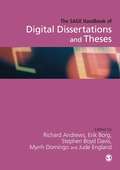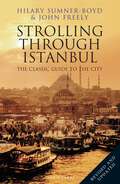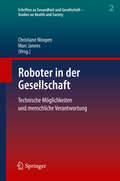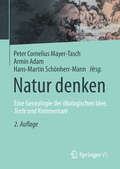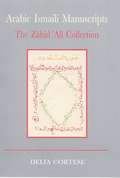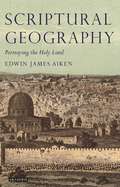- Table View
- List View
The Black Death in the Middle East (Princeton Legacy Library #5354)
by Michael Walters DolsIn the middle of the fourteenth century a devastating epidemic of plague, commonly known in European history as the "Black Death," swept over the Eurasian continent. This book, based principally on Arabic sources, establishes the means of transmission and the chronology of the plague pandemic's advance through the Middle East.The prolonged reduction of population that began with the Black Death was of fundamental significance to the social and economic history of Egypt and Syria in the later Middle Ages. The epidemic's spread suggests a remarkable destruction of human life in the fourteenth century, and a series of plague recurrences appreciably retarted population growth and the following century and a half, impoverishing Middle Eastern society. Social reactions illustrate the strength of traditional Muslism values and practices, social organization, and cohesiveness. The sudden demographic decline brought about long-term as well as immediate economic adjustments in land values, salaries, and commerce.Michael W. Dols is Assistant Professor of History at California State University, Hayward.Originally published in 1977.The Princeton Legacy Library uses the latest print-on-demand technology to again make available previously out-of-print books from the distinguished backlist of Princeton University Press. These editions preserve the original texts of these important books while presenting them in durable paperback and hardcover editions. The goal of the Princeton Legacy Library is to vastly increase access to the rich scholarly heritage found in the thousands of books published by Princeton University Press since its founding in 1905.
Throne of Wisdom (Princeton Legacy Library #5366)
by Ilene H. ForsythThe wooden statue of the Mother and Child enthroned, known as sedes sapientiae, the Seat or Throne of Wisdom, reached the brilliant culmination of its development as a genre of religious sculpture in the twelfth century. As a visible expression of the mystery of Incarnation, its iconography dated back to the early church. Translated by the Romanesque sculptor into a fully plastic, freestanding form, its style conveys convincingly the medieval vision of humanity and divinity interfused.The recent cleaning and restoration of a number of these wood-carved figures of the Madonna in Majesty has now made possible a full appraisal of the genre. Mrs. Forsyth's discussion examines the character, function, iconography, and history of the statues; distinguishes types and regional styles; considers their role within the broader context of medieval art; and assesses their artistic merit. Her register of principal examples includes 110 sculptures dating from twelfth century France, some of which have never been published before. 192 illustrations accompany the text.Ilene H. Forsyth is Associate Professor in the Department of the History of Art, at the University of Michigan.Originally published in 1972.The Princeton Legacy Library uses the latest print-on-demand technology to again make available previously out-of-print books from the distinguished backlist of Princeton University Press. These editions preserve the original texts of these important books while presenting them in durable paperback and hardcover editions. The goal of the Princeton Legacy Library is to vastly increase access to the rich scholarly heritage found in the thousands of books published by Princeton University Press since its founding in 1905.
On the Cognitive, Ethical, and Scientific Dimensions of Artificial Intelligence: Themes from IACAP 2016 (Philosophical Studies Series #134)
by Don Berkich Matteo Vincenzo D'AlfonsoThis edited volume explores the intersection between philosophy and computing. It features work presented at the 2016 annual meeting of the International Association for Computing and Philosophy. The 23 contributions to this volume neatly represent a cross section of 40 papers, four keynote addresses, and eight symposia as they cut across six distinct research agendas. The volume begins with foundational studies in computation and information, epistemology and philosophy of science, and logic. The contributions next examine research into computational aspects of cognition and philosophy of mind. This leads to a look at moral dimensions of man-machine interaction as well as issues of trust, privacy, and justice. This multi-disciplinary or, better yet, a-disciplinary investigation reveals the fruitfulness of erasing distinctions among and boundaries between established academic disciplines. This should come as no surprise. The computational turn itself is a-disciplinary and no former discipline, whether scientific, artistic, or humanistic, has remained unchanged. Rigorous reflection on the nature of these changes opens the door to inquiry into the nature of the world, what constitutes our knowledge of it, and our understanding of our place in it. These investigations are only just beginning. The contributions to this volume make this clear: many encourage further research and end with open questions.
Branding Television
by Catherine JohnsonBranding Television examines why and how the UK and US television industries have turned towards branding as a strategy in response to the rise of satellite, cable and digital television, and new media, such as the internet and mobile phone. This is the first book to offer a sustained critical analysis of this new cultural development. Branding Television examines the industrial, regulatory and technological changes since the 1980s in the UK and the USA that have led to the adoption of branding as broadcasters have attempted to manage the behaviour of viewers and the values associated with their channels, services and programmes in a world of increased choice and interactivity. Wide-ranging case studies drawn from commercial, public service, network and cable/satellite television (from NBC and HBO to MTV, and from BBC and Channel 4 to UKTV and Sky) analyse the role of marketing and design in branding channels and corporations, and the development of programmes as brands. Exploring both successful and controversial uses of branding, this book asks what problems there are in creating television brands and whether branding supports or undermines commercial and public service broadcasting. Branding Television extends and complicates our understanding of the changes to television over the past 30 years and of the role of branding in contemporary Western culture. It will be of particular interest to students and researchers in television studies, but also in creative industries and media and cultural studies more generally.
Branding Television (PDF)
by Catherine JohnsonBranding Television examines why and how the UK and US television industries have turned towards branding as a strategy in response to the rise of satellite, cable and digital television, and new media, such as the internet and mobile phone. This is the first book to offer a sustained critical analysis of this new cultural development. Branding Television examines the industrial, regulatory and technological changes since the 1980s in the UK and the USA that have led to the adoption of branding as broadcasters have attempted to manage the behaviour of viewers and the values associated with their channels, services and programmes in a world of increased choice and interactivity. Wide-ranging case studies drawn from commercial, public service, network and cable/satellite television (from NBC and HBO to MTV, and from BBC and Channel 4 to UKTV and Sky) analyse the role of marketing and design in branding channels and corporations, and the development of programmes as brands. Exploring both successful and controversial uses of branding, this book asks what problems there are in creating television brands and whether branding supports or undermines commercial and public service broadcasting. Branding Television extends and complicates our understanding of the changes to television over the past 30 years and of the role of branding in contemporary Western culture. It will be of particular interest to students and researchers in television studies, but also in creative industries and media and cultural studies more generally.
Diagramming the Big Idea: Methods for Architectural Composition
by Jeffrey Balmer Michael T. SwisherBecoming an architect is a daunting task. Beyond the acquisition of new skills and procedures, beginning designers face an entirely unfamiliar mode of knowledge: design thinking. In Diagramming the Big Idea, Jeffrey Balmer and Michael T. Swisher introduce the fundamentals of design thinking by illustrating how architects make and use diagrams to clarify their understanding of both specific architectural projects and universal principles of form and order. With accessible, step-by-step procedures that interweave diagrams, drawings and virtual models, the authors demonstrate how to compose clear and revealing diagrams. Design thinking defines a method for engaging the world through observation and analysis. Beyond problem solving, design is a search for possibilities. Mastering design thinking begins with learning the fundamentals of visual composition. It embraces the ability to synthesize deductive and imaginative reasoning, combining both shrewd scrutiny and fevered speculation. Design diagrams make visible the abstractions that order the built environment. Premised upon the Beaux-Arts notion of the architectural parti, Balmer and Swisher adopt the ‘Big Idea’ as a foil and as a suitcase to organize fundamentals of architectural composition. The goal of this book is to make explicit to students what they are learning, why they are learning it and how to internalize such lessons toward their lifelong development as designers.
English School Exercises, 1420-1530 (Studies And Texts #181 (PDF))
by Nicholas Orme Pontifical Institute of Mediaeval Studies Staff"In his latest of many distinguished contributions to the history of medieval education, Nicholas Orme edits and translates into modern English twelve sets of the translation exercises known as 'latins.' Devised to teach Anglophone boys the basics of Latin composition, these hundreds of short texts do much more than illustrate pedagogical methods that continued in use even as medieval gave way to humanist Latin in the schools. They provide fascinating glimpses of fifteenth- and early sixteenth-century English popular culture and everyday life as viewed by adolescents aspiring to worldly success while enduring outbreaks of plague, bad meals, and especially the master's harsh discipline. In his introductions and annotations, Orme draws on his unsurpassed knowledge of English grammar schools to contextualize and enhance these vivid images. Historians of education may be the principal audience for the book, but anyone interested in medieval language, customs, and institutions will consult it with pleasure and profit." -Martin Camargo, University of Illinois at Urbana-Champaign
Consumer Protection In The Age Of The 'information Economy' (PDF)
by Jane K. WinnTo date, there have been few theoretical inquiries into the relationship between the technological innovation and basic objectives of consumer protection laws. This book addresses this need by considering the impact of technological innovation on the foundations of consumer advocacy, contracting behaviour, control over intellectual capital and information privacy. The collection presents a unique and timely perspective on these issues. The authors, internationally renowned experts, from diverse areas such as consumer issues in technology markets, contract, and intellectual property provide a fresh perspective on these topics. Contributions provide novel approaches to the question of what consumer protection might consist of in the context of technological innovation. The book will be a valuable resource to academics and researchers in law and public policy and is easily accessible to graduate and undergraduate students working in these areas.
Consumer Protection In The Age Of The 'information Economy'
by Jane K. WinnTo date, there have been few theoretical inquiries into the relationship between the technological innovation and basic objectives of consumer protection laws. This book addresses this need by considering the impact of technological innovation on the foundations of consumer advocacy, contracting behaviour, control over intellectual capital and information privacy. The collection presents a unique and timely perspective on these issues. The authors, internationally renowned experts, from diverse areas such as consumer issues in technology markets, contract, and intellectual property provide a fresh perspective on these topics. Contributions provide novel approaches to the question of what consumer protection might consist of in the context of technological innovation. The book will be a valuable resource to academics and researchers in law and public policy and is easily accessible to graduate and undergraduate students working in these areas.
Further Advances in Pragmatics and Philosophy: Part 2 Theories and Applications (Perspectives in Pragmatics, Philosophy & Psychology #20)
by Alessandro Capone Marco Carapezza Franco Lo PiparoThe two sections of this volume present theoretical developments and practical applicative papers respectively. Theoretical papers cover topics such as intercultural pragmatics, evolutionism, argumentation theory, pragmatics and law, the semantics/pragmatics debate, slurs, and more. The applied papers focus on topics such as pragmatic disorders, mapping places of origin, stance-taking, societal pragmatics, and cultural linguistics. This is the second volume of invited papers that were presented at the inaugural Pragmasofia conference in Palermo in 2016, and like its predecessor presents papers by well-known philosophers, linguists, and a semiotician. The papers present a wide variety of perspectives independent from any one school of thought.
Urban Plots, Organizing Cities (PDF)
by Claudio Coletta Giovanna Sonda Francesco GabbiBy focusing on the interplay between material, social and narrative dimensions of the city, this book examines urban complexity, namely the dynamic and entangled nature of urban issues, and puts forward a notion of the city as an urban texture. Taking an innovative interdisciplinary approach, it perceives the way cities are organized as a restless stratification of materials, meanings and uses, and deals with the interrelationships between actors, places, administrative rationalities and artefacts. It argues that urban fabric is 'manufactured' in this interplay between imagery and practices (of all the stake-holders, including planners, city managers and city users). Illustrated by in-depth empirical studies from across Europe and Latin America, the book explores material and symbolic aspects of the urban experience. In particular, the contributors focus on the less visible ways of organizing urban spaces, such as those enacted and embodied by local news, artefacts such as signals, maps, regulations, public acts, artistic performances, sensory experience and collective memories. The book offers an articulated discussion on these various means of spatial organisation, thereby providing insights into situations of conflict and proposing innovative ways forward for enhancing urban sociability.
Urban Plots, Organizing Cities
by Claudio Coletta Giovanna Sonda Francesco GabbiBy focusing on the interplay between material, social and narrative dimensions of the city, this book examines urban complexity, namely the dynamic and entangled nature of urban issues, and puts forward a notion of the city as an urban texture. Taking an innovative interdisciplinary approach, it perceives the way cities are organized as a restless stratification of materials, meanings and uses, and deals with the interrelationships between actors, places, administrative rationalities and artefacts. It argues that urban fabric is 'manufactured' in this interplay between imagery and practices (of all the stake-holders, including planners, city managers and city users). Illustrated by in-depth empirical studies from across Europe and Latin America, the book explores material and symbolic aspects of the urban experience. In particular, the contributors focus on the less visible ways of organizing urban spaces, such as those enacted and embodied by local news, artefacts such as signals, maps, regulations, public acts, artistic performances, sensory experience and collective memories. The book offers an articulated discussion on these various means of spatial organisation, thereby providing insights into situations of conflict and proposing innovative ways forward for enhancing urban sociability.
The Sports Shoe: A History from Field to Fashion
by Thomas TurnerThe story of the sneaker's rise from the first Victorian tennis shoes to the Nike Air Max and beyond Moving from the athletic field to the shopping mall, Thomas Turner tells a fresh story of the evolution of the sports shoe against the changing landscape of society, sport, fashion, industry, and technology. The Sports Shoe takes us on a journey from the first Victorian tennis shoes to the adidas Superstar and the innovative technologies of Nike Air Max. Featuring newly uncovered archival material and historic images showcasing key personalities, vintage marketing and common perceptions of this hugely desirable product, this book is a must-have for any sneaker collector, historian of popular culture, or anyone interested in the place of athletic footwear in our lives today.
Concise Garden Bird Guide (Concise Guides)
by BloomsburyThis beautifully illustrated mini field guide is first and foremost a garden bird identification guide containing detailed descriptions of the most commonly encountered species, as well as some rarities and birds you may only see flying overhead in gardens. Eighty-eight species, illustrated with more than 400 superb full-colour artworks, are covered. The book also includes general guidelines on food, feeders, nest boxes and other items that can greatly increase the presence of birds in your garden. A concise written account for each species covers data such as size, general description, voice, habitat, food, occurrence in gardens, and distribution in Britain and the near Continent. The easy-to-follow layouts and superb artworks aid quick and accurate identification, making the book an indispensable reference in the field as well as in the home and garden.The illustrators include renowned natural history artists Sandra Doyle, Dan Cole, Szabolcs Kokay, Steven Message, Bridgette James and David Sutton.
The Penguin Classics Book: In Search of the Best Books Ever Written
by Henry EliotPenguin Classics is the largest and best-known classics imprint in the world. From The Epic of Gilgamesh to the poetry of the First World War, and covering all the greatest works of fiction, poetry, drama, history and philosophy in between, this reader's companion encompasses 500 authors, 1,200 books and 4,000 years of world literature.Stuffed full of stories, author biographies, book summaries and recommendations, and illustrated with thousands of historic Penguin Classic covers, this is an exhilarating and comprehensive guide for anyone who wants to explore and discover the best books ever written.
From Stars to Brains: Milestones in the Planetary Evolution of Life and Intelligence
by Andrew Y. GliksonThe permutation of basic atoms—nitrogen, hydrogen, oxygen, carbon and phosphorus―into the biomolecules DNA and RNA, subsequently evolved in cells and brains, defining the origin of life and intelligence, remains unexplained. Equally the origin of the genetic information and the intertwined nature of ‘hardware’ and ‘software’ involved in the evolution of bio-molecules and the cells are shrouded in mystery. This treatise aims at exploring individual and swarm behaviour patterns which potentially hint at as yet unknown biological principles. It reviews theories of evolution with perspectives from the earth sciences, commencing with the earliest observed records of life. This is followed by reviews and discussion of the building blocks of life, marine and terrestrial communities, the arthropods, birds and finally humans. It is suggested that, further to the mutation/natural selection processes established by Darwin and Wallace, an understanding of the evolution of intelligence remains little understood. A directionality of evolutionary trajectories is evident, not least the purposeful thinking process of humans as well as animals. It is not clear how directional intelligence, manifested for example by the collective intelligence of arthropod colonies, has evolved from mutation/natural selection processes. Potential clues for the understanding of life and evolution are provided by Aristotle’s dictum of “the whole being greater than the sum of the parts”, Niels Bohr’s principle of quantum complementarity and George Ellis’ theory of top-down causality. Inherent in the question of the origin of life is an anthropocentric bias, related to the self-referential Anthropic Principle and theological paradigms of man’s supposed dominion over all other species. The Anthropic Principle, however, should be capable of being circumvented using the scientific falsification method, assuming universal verified constants of physics. The phenomenon of the human mastery of fire and the splitting of the atom, leading to the seventh major mass extinction of species, remains incomprehensible.
The International Element, Statehood and Democratic Nation-building: Exploring the Role of the EU and International Community in Kosovo’s State-formation and State-building
by Dren DoliThis book represents a unique endeavor to elucidate the story of Kosovo’s unilateral quest for statehood. It is an inquiry into the international legal aspects and processes that shaped and surrounded the creation of the state of Kosovo. Being created outside the post-colonial context, Kosovo offers a unique yet controversial example of state emergence both in the theory and practice of creation of states. Accordingly, the book investigates the legal pathways, strategies, developments and policy positions of international agencies/actors and regional players (in particular the EU) that helped Kosovo to establish its independence and gradually acquire statehood. Although contested, Kosovo, and its quest for statehood, represents a unique example of successful unilateral secession. The book therefore explores and analyses patterns of state formation and nation-building in Kosovo, and its transition to democracy. It presents a three-level assessment. First, seen from a historical perspective, the book examines the validity of the right of Kosovar-Albanians to self-determination and remedial secession. Second, from a legal positivist perspective, it scrutinizes all of the legalist arguments that support Kosovo’s right to statehood, and claims that both traditional and legality-based criteria for statehood remain insufficient to determine whether Kosovo has achieved statehood. Third, from a post-factum perspective, the book analyzes the scope and extent to which the internationally blended element was decisive in Kosovo’s state-formation and state-building processes. It explains how the EU’s involvement as an ‘internationally blended element’ in Kosovo’s efforts to achieve statehood was instrumental and played a crucial role in shaping the emerging state. In particular, the book elaborates on how the EU was able to streamline its mode of intervention in the context of state-building and reform.
The Ethics of Medical Data Donation (Philosophical Studies Series #137)
by Jenny Krutzinna Luciano FloridiThis open access book presents an ethical approach to utilizing personal medical data. It features essays that combine academic argument with practical application of ethical principles. The contributors are experts in ethics and law. They address the challenges in the re-use of medical data of the deceased on a voluntary basis. This pioneering study looks at the many factors involved when individuals and organizations wish to share information for research, policy-making, and humanitarian purposes. Today, it is easy to donate blood or even organs, but it is virtually impossible to donate one’s own medical data. This is seen as ethically unacceptable. Yet, data donation can greatly benefit the welfare of our societies. This collection provides timely interdisciplinary research on biomedical big data. Topics include the ethics of data donation, the legal and regulatory challenges, and the current and future collaborations. Readers will learn about the ethical and regulatory challenges associated with medical data donations. They will also better understand the special nature of using deceased data for research purposes with regard to ethical principles of autonomy, beneficence, and justice. In addition, the contributors identify the key governance issues of such a scheme. The essays also look at what we can learn in terms of best practice from existing medical data schemes.
Lacan Reframed: Interpreting Key Thinkers for the Arts (Contemporary Thinkers Reframed)
by Steven Z. LevineAre your students baffled by Baudrillard? Dazed by Deleuze? Confused by Kristeva? Other beginners' guides can feel as impenetrable as the original texts to students who 'think in images'. Contemporary Thinkers Reframed instead uses the language of the arts to explore the usefulness in practice of complex ideas. Short, contemporary and accessible, these lively books utilise actual examples of artworks, films, television shows, works of architecture, fashion and even computer games to explain and explore the work of the most commonly taught thinkers. Conceived specifically for the visually minded, the series will prove invaluable to practitioners an students right across the visual arts.Single-handedly responsible for the influential and ominous notion of 'the gaze', quoted by everybody yet fully understood by few, Lacan's work can be difficult to grasp. Going back to basics, this introduction guides the reader through Lacan's key concepts by looking at art from the Mona Lisa through to Bridget Riley's paintings, and by looking afresh at key works discussed by Lacan himself, from Holbein's famous 'The Ambassadors' to Velazquez's 'Las Meninas'. Making sense of Lacan's sometimes convoluted style, this highly readable introduction to one of the most frequently quoted thinkers also explores the reasons why human beings make - and look at - art.
The SAGE Handbook of Digital Dissertations and Theses: SAGE Publications
by Erik Borg Jude England Myrrh Domingo Stephen N. Davis Mr Richard N. L. AndrewsThis handbook sets out the processes and products of 'digital' research. It is a theoretical and practical guide on how to undertake and navigate advanced research in the arts, humanities and social sciences. Topics covered include: - how to make research more accessible - the use of search engines and other sources to determine the scope of work - research training for students - what will theses, dissertations and research reports look like in ten years' time? - the storing and archiving of such research - ethics and methodologies in the field - intercultural issues The editors focus on advances in arts and practice-based doctorates, and their application in other fields and disciplines. The contributions chart new territory for universities, research project directors, supervisors and research students regarding the nature and format of Masters and doctoral work, as well as research projects. This handbook is an essential reference for researchers, supervisors and administrators on how to conduct and evaluate research projects in a digital and multimodal age. Richard Andrews is Professor in English, Faculty of Children and Learning, Institute of Education. Erik Borg is a Senior Lecturer at Coventry University's Centre for Academic Writing. Stephen Boyd Davis is Research Leader in the School of Design, Royal College of Art. Myrrh Domingo is Visiting Assistant Professor in English Education and Literacy Education at New York University. Jude England is Head of Social Sciences at the British Library.
Strolling Through Istanbul: The Classic Guide to the City
by Hilary Sumner-Boyd John FreelyThis classic guide to Istanbul by Hilary Sumner-Boyd and John Freely - the 'best travel guide to Istanbul' (The Times), 'a guide book that reads like a novel' (New York Times) - is here, for the first time since its original publication thirty-seven years ago, published in a completely revised and updated new edition. Taking the reader on foot through this captivating city - European Capital of Culture 2010 - the authors describe the historic monuments and sites of what was once Constantinople and the capital in turn of the Byzantine and Ottoman Empires, in the context of the great living city. Woven throughout are lively anecdotes, secret histories, hidden gems and every major place of interest the traveller will want to see. Practical and informative, readable and vividly described, this is the definitive guide to and story of Istanbul, by those who know it best.'The best travel guide to Istanbul' - The Times
Roboter in der Gesellschaft: Technische Möglichkeiten und menschliche Verantwortung (Schriften zu Gesundheit und Gesellschaft - Studies on Health and Society #2)
by Christiane Woopen Marc JannesDas Buch betrachtet den Einsatz der Robotik in Gesundheit, Wirtschafts- und Arbeitswelt aus interdisziplinärer Perspektive. Immer eigenständigere Roboter halten Einzug in unseren Alltag. Bereits heute übernehmen sie eine Vielzahl von Aufgaben z. B. in der produzierenden Industrie oder der Medizin. Diese maschinellen Systeme agieren in atemberaubendem Tempo immer unabhängiger von menschlicher Steuerung. In zunehmendem Maße sind sie in der Lage, auch komplexere Schlussfolgerungen zu ziehen. All dies wirft eine Vielzahl ethischer und juristischer Fragen auf: Wie verändern automatisierte Systeme unser Leben und Selbstverständnis? Vor welchen Herausforderungen stehen Arbeitswelt, öffentlicher Raum und Pflege? Experten aus Wissenschaft und Politik beleuchten diese und weitere Fragen innerhalb des vorliegenden Bandes.
Natur denken: Eine Genealogie der ökologischen Idee. Texte und Kommentare
by Peter Cornelius Mayer-Tasch Armin Adam Hans-Martin Schönherr-MannDieses Buch bietet einen weit zurückgreifenden Einblick in die abendländische Naturphilosophie. Beginnend mit den Vorsokratikern als erstem Höhepunkt des europäischen Naturbegriffs erfasst der Band alle Epochen der Geistesgeschichte: die Antike, christliche und mittelalterliche Naturvorstellungen, die Revolution des Naturdenkens in der Renaissance, den neuzeitlichen Naturbegriff und die grundlegenden Denker der Moderne. „Natur denken“ wird somit zur unverzichtbaren Grundlage gerade für diejenigen, die sich mit einem nachhaltigen Umgang mit der Natur beschäftigen müssen. Der Inhalt· Antike Naturvorstellungen· Christliche und mittelalterliche Naturvorstellungen· Naturvorstellungen in der Renaissance· Neuzeitliche Naturvorstellungen· Denker des Übergangs Die Zielgruppen· Philosophen· Ökologen· Sozialwissenschaftler· Politikwissenschaftler Die HerausgeberProf. Dr. Peter Cornelius Mayer-Tasch ist Professor für Politikwissenschaft und Rechtstheorie an der Ludwig-Maximilians-Universität München und Altrektor der Hochschule für Politik München.Dr. Armin Adam lehrte am Geschwister-Scholl-Institut für Politische Wissenschaft der Ludwig-Maximilians-Universität München.Prof. Dr. Hans-Martin Schönherr lehrt Politische Philosophie am Geschwister-Scholl-Institut der Ludwig-Maximilians-Universität München.
Arabic Ismaili Manuscripts: The Zahid Ali Collection
by Delia CorteseThis work represents a brilliant corpus of Islamic manuscripts devoted to the theological, philosophical and historical traditions of the Fatimid, post-Fatimid Yemeni as well as Indian-Ismaili literature. The catalogue, with its 179 annotated entries which examine the literary and doctrinal aspects of these manuscripts, features incipits in Arabic for each entry and is supported by indices in both Arabic and Latin scripts. The work is fully illustrated and enriched by a comprehensive contextualising introduction. It will prove an invaluable tool for scholars and researchers interested in the study of key-texts from the early Islamic period.
Scriptural Geography: Portraying the Holy Land (Tauris Historical Geographical Series)
by Edwin James AikenIt is easy to find Palestine... But how to find the Holy Land -- ah, that is another matter' (Out-of Doors in the Holy Land, 1908)Geographies of the Holy Land are almost as old as Christianity itself. In the ancient world works such as the Onomasticon of Eusebius were intended primarily as aids to biblical understanding but by the early nineteenth century books about the Holy Land had become entangled in concerns over the relationship between the scriptural and scientific uses of this sacred landscape. The Holy Land was not just a physical region on the surface of the Earth - it was an idea, an intellectual and moral space charged with the heat of religious debate and with the noisy engagements of those trying to understand the religious, social and scientific upheavals of the time. EdwinJames Aiken explores the various ways in which geographical knowledge was used in the management of this celestial landscape and the production of its geography. In particular he shows how religious writers called upon geographical knowledge in different ways at different times to the benefit of their readers. He pays particular attention to the political, social and religious currents at play and to the dissonance between religion, theology and science. The result is an original and stimulating work of scholarship that demonstrates the significance of the geography of the Holy Land in Western thought and argument and makes important contributions to the history of geography, the nature of Orientalism, and to the evolving relationship between religion and science.
